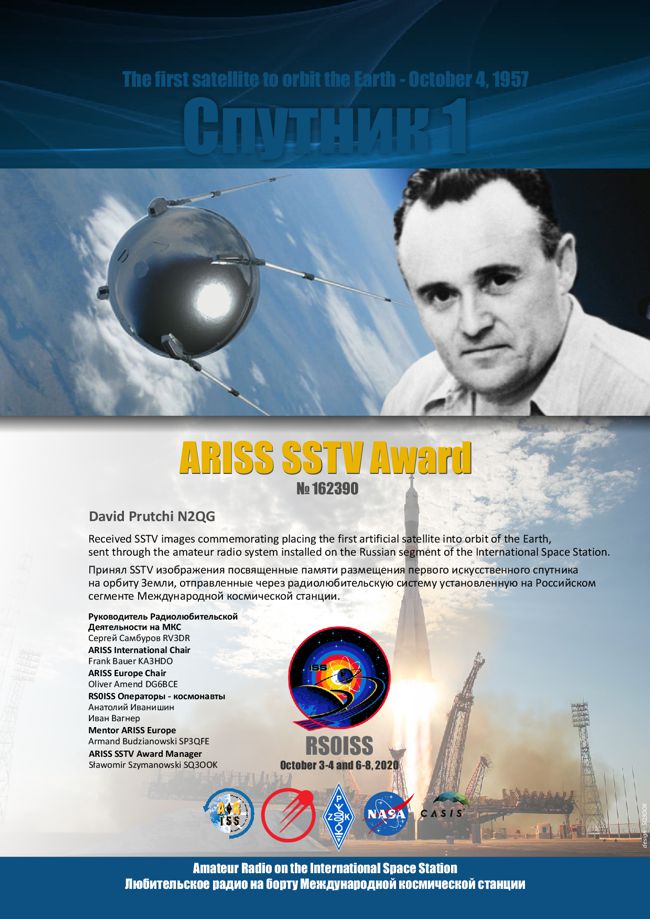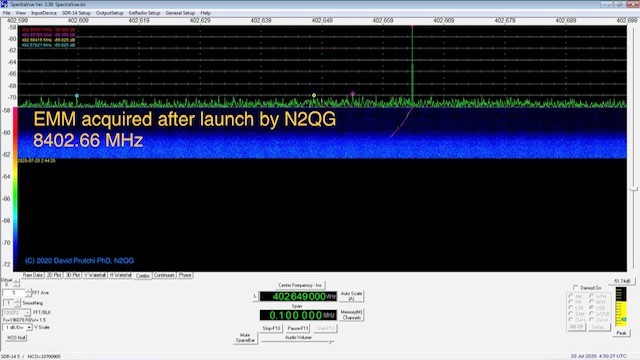
New one to me: received the fast-moving Mars Atmosphere and Volatile EvolutioN (MAVEN) orbiter while locked to Madrid DSN using the 1.2m offset dish antenna.
Cutting-edge diy projects

New one to me: received the fast-moving Mars Atmosphere and Volatile EvolutioN (MAVEN) orbiter while locked to Madrid DSN using the 1.2m offset dish antenna.
I’ve been working on my system for receiving signals from deep-space spacecraft since the summer of 2019 when KC2TDS and I built an X-band circular polarization feed and downconverter that we tested at MUD 2019.
My first true-DSN X-band reception happened in May 2020. I was able to receive and track Bepi-Colombo, which at that time was 15.2 million km away from Earth. The signal was received with the feed built by KC2TDS mounted on a 1.2m f/d=0.6 offset dish steered by a Yaesu G-5500 az/el rotator. I used a Kuhne LNA-8000B low-noise amplifier connected directly to the probe, and the amplified signal was sent to the N2QG downconverter (LO=8GHz) mounted on the boom. Downconverted signals (400 – 450 MHz) were received using an AOR AR-5000. The radio’s IF was sampled by an SDR-14 and displayed with SpectraVue. Tracking of the probe was with PstRotator’s DSN feature.
Figure 1 – Block diagram of N2QG’s X-band Amateur DSN station in June 2020.
I purchased a squeezed-tube depolarizer and super Kumar scalar ring from M0EYT (from uhf-satcom.com). KC2TDS terminated it with a waterjet-cut copper disk and added a probe which he carefully tuned with the VNA to get <20dB return loss in the 8.4 to 8.45GHz DSN band. I mounted this feed on my 3.5m dish and was able to receive Mars Express, MRO, and OSIRIS-ReX.
Despite carefully tweaking the feed, I’ve been unable to get the system mounted on the 3.5m dish to yield the signal levels that I’m expecting. I suspect surface accuracy is the culprit because the 3.5m dish behaves well at 1296 MHz, but the g/t is just not there at 8.45 GHz. I can receive Bepi-Colombo on the 1.2m dish with around 12 dB compared to 16dB on the 3.5m dish. However, M0EYT receives it at around 30dB on his 2.4m prime dish. In July I worked on decreasing the SNR of the downconverter, which improved signals some, but definitely not as much as I would have liked to receive from a 3.5m dish.
Towards the end of that month I returned the X-band feed and downconverter to the 1.2m offset dish because I needed the 3.5m dish to participate in the EME SSTV Moon Landing Party hosted by PI9CAM at Dwingeloo Radio-Observatory in the Netherlands.
The Hope Emirates Mars Mission (EMM), Mars 2020 Perseverance, and Tianwen-1 launched right around that time, and I’ve been able to track them all with the 1.2m dish.
Juno remains out of my reach, so I’m considering next steps to improve my system. I thought that this would be a good point in time to summarize my experience so far, and discuss out loud plans for the future in case that it helps someone else who is just getting started in Amateur DSN. CLICK HERE for my whitepaper “Amateur DSN Lessons Learned (so far…).”

This was a really difficult set to receive. Took 3 days worth of passes to receive all 16 images.


Impulse Dynamics, Inc., a company dedicated to improving the lives of people with heart failure, today announced its innovative CCM® therapy delivered by the Optimizer® system received an award from the R&D 100 Awards, a prestigious program honoring research and development pioneers and their revolutionary ideas in science and technology.
“Winning this award is a tremendous accomplishment for our company as it represents the recognition by fellow scientists and engineers for the enormous effort that has gone into developing this breakthrough technology. The therapy serves a huge unmet need for a very large group of heart failure patients who suffer every day with their symptoms, so it’s great for the technology to receive recognition at this level,” said David Prutchi, Ph.D., Chief Technology Officer and Executive Vice President at Impulse Dynamics. “I am pleased to congratulate all my colleagues that helped evolve what was initially an intriguing electrophysiological discovery into the transformational therapy that it is today.”
Impulse Dynamics’ website: www.impulse-dynamics.com

Woke up in the middle of the night to take a look at the signal from Mars 2020 launched yesterday morning. The signal exhibits a rotation Doppler component.
M0EYT let the Amateur DSN group know that Jon at JPL had loaded Tianwen-1’s ephemeris to Horizons, so I quickly added it to PstRotator:

I’d seen the reports on the strength of its x-band signal, but holy mackerel, it is huge even on my 1.2m offset dish at a range of 2.6 million km!
 My plan for this weekend is to move the dual-polarization VE4MA feed to the 3.5m dish to track the Mars-bound flotilla (Emirates Mars Mission, Mars 2020, and Tianwen-1).
My plan for this weekend is to move the dual-polarization VE4MA feed to the 3.5m dish to track the Mars-bound flotilla (Emirates Mars Mission, Mars 2020, and Tianwen-1).

Had so much fun today receiving the images transmitted by the Dwingeloo Radio Observatory’s PI9CAM team via 1296 MHz EME SSTV to celebrate the 51st anniversary of the Apollo XI Moon Landing!
As an added bonus, PI9CAM was able to receive the images that I transmitted with my 3.5m dish and 400W at the feed.



The Emirates Hope Mars Mission (EMM) Spacecraft launched yesterday from Japan using a Mitsubishi Heavy Industries H-IIA launcher. I was able to acquire its signal as soon as it cleared my local horizon. The screenshot above shows my house’s thermal noise fading away as the spacecraft gained elevation, to finally yield a clean signal past midnight (local time). Continue reading→

1296 MHz was bustling with contest activity this morning. Great signals made it easy to tweak RX and tracking in preparation of next weekend’s EME SSTV Moon Landing Party hosted by PI9CAM at Dwingeloo Radio-Observatory in the Netherlands.
In preparation for tracking the UAE’s Hope Mars Mission, I also tweaked my DSN X-band downconverter to improve S/N. The latest configuration is as follows:

Click here for larger picture.

I’ve been planning ahead to the day when I retire, my girls live on their own, and my wife and I can finally take the big-RV roadtrip that we’ve been talking about forever. Not being one for sitting by a campfire, I’m always collecting equipment to take along, and some time ago my ongoing eBay® search for a collapsible parabolic antenna hit gold. It was for an EchoSphere 7.5 ft TVRO folding dish in mint condition. It even came with an extra (slightly damaged) reflector assembly to boot! My plan is to build feeds for 1296 MHz EME and S-Band DSN. Sadly, 10 GHz EME and X-band DSN are out of range for the reflector’s fabric.

The EchoStar RV-750 comes in a carry bag. It can be assembled and deployed in lessa than 10 minutes (c)2020 David Prutchi PhD N2QG
Finding information on this dish has been much more difficult than I had anticipated. I summarized my literature and experimental findings in a short write-up available at: The EchoStar RV-750 Antenna by N2QG Continue reading→

I moved the X-band setup to the 1.2m offset dish to be able to characterize and diagnose. The problem is that I’m unable to get the system mounted on the 3.5m dish to yield the signal levels that I’m expecting. I’m suspecting surface accuracy because the 3.5m dish behaves well at 1296 MHz, but the g/t is just not there at 8.45 GHz.
I can receive BepiColombo on the 1.2m dish with around 12 dB compared to 16dB on the 3.5m dish. However, M0EYT receives it at around 30dB on his 2.4m prime dish.
Is it time for my garden to grow a new large solid dish?